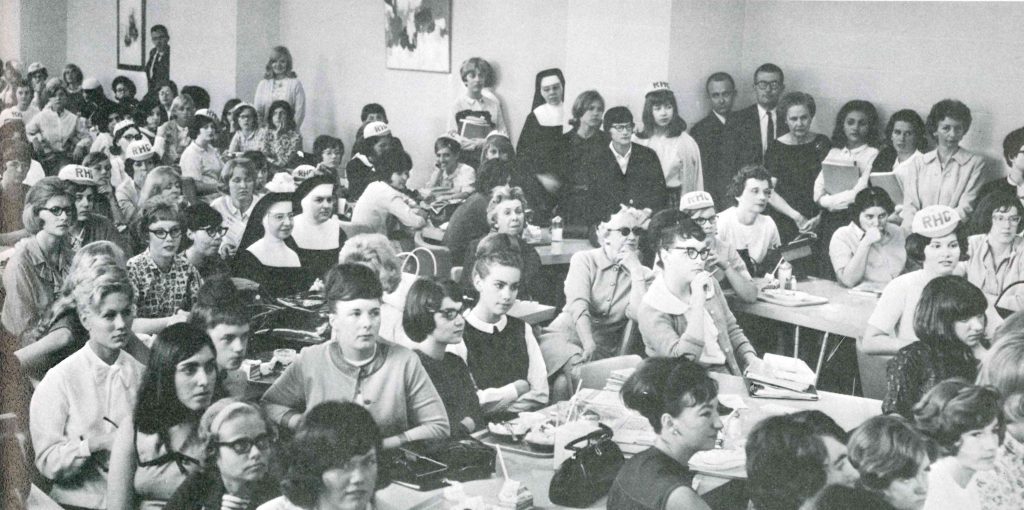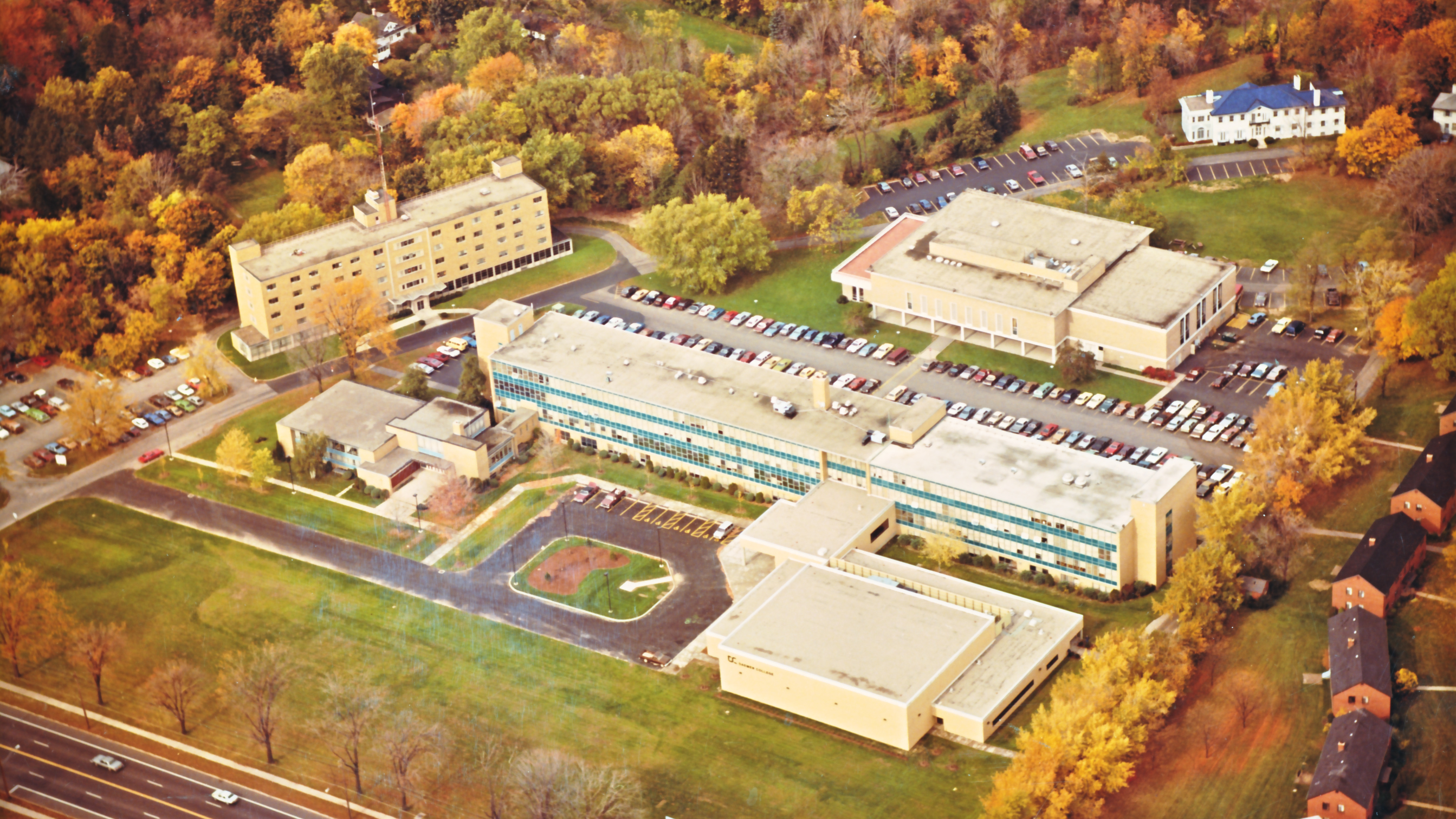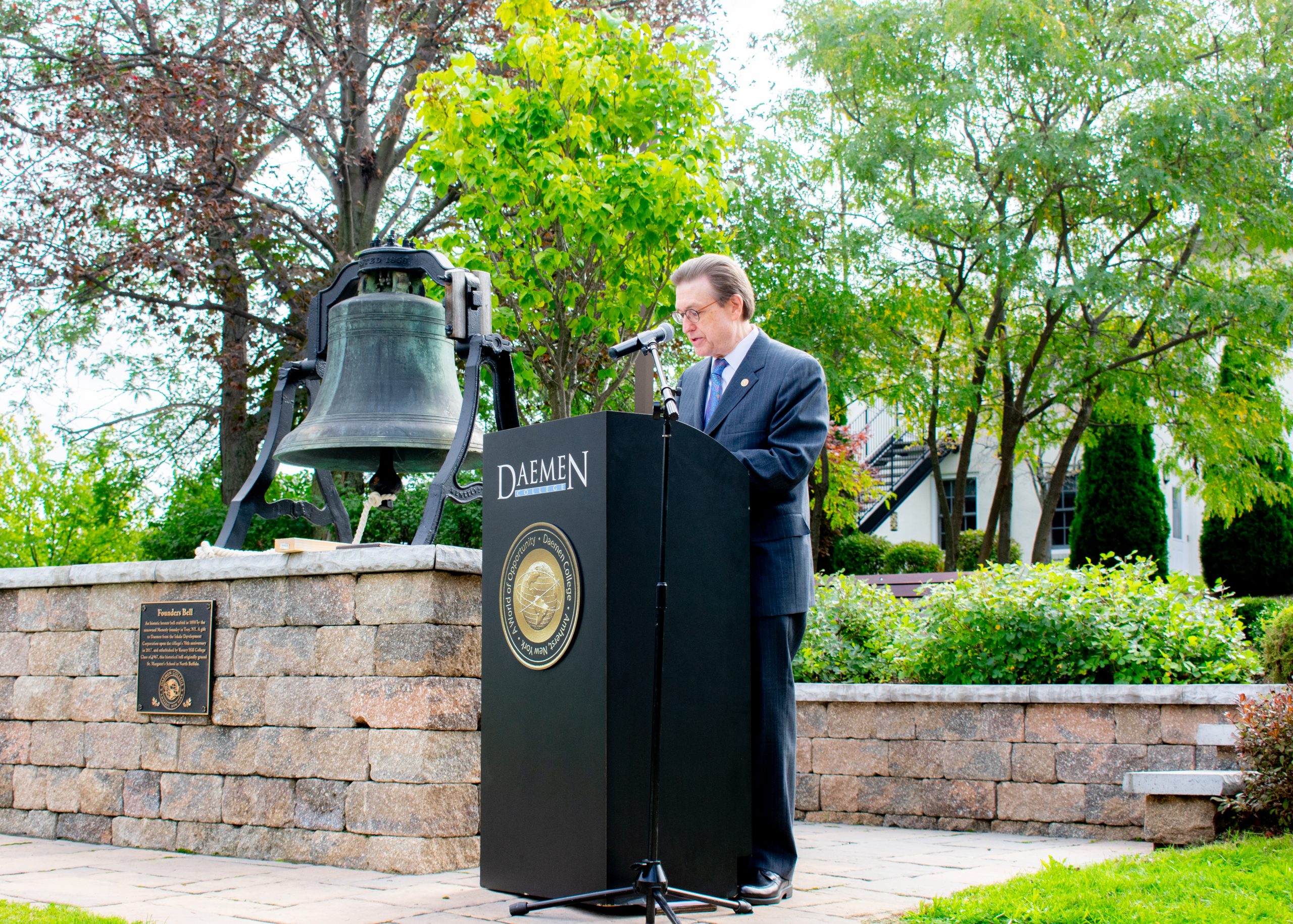The Daemen University of today is the modern realization, in many ways, of the institution imagined and created by its founders.
Throughout its history, as the school marked its 10th, 25th, 50th – and anniversaries in between – its leaders planned for a future that has come into being. Their dreams and ambitions have led Daemen to occupy a position of strength unlike at any other time in its history.
At 75, the university is a study in what it takes to adapt to survive and thrive, while holding true to the fundamental values and aspirations that inspired its creation in the first place. It has also reached new levels of excellence and national visibility in recent years and is now embarking on some of its most ambitious projects in its history.
What’s next for Daemen is to become no less than a more perfect fulfillment of the institution envisioned by its founders in 1947, when a small group of nuns knocked on the door of a family’s mansion off Main Street in Amherst and asked to buy the building (now Rosary Hall) to start a new college for women.
“Each student, instructor, staff person, administrator, trustee, and general supporter,” wrote Dea McKenna McAuliffe ’58, in a history of the institution, “has contributed a piece to the gleaming mosaic we know as Daemen.”
Daemen is all of our experiences – and those to come for the students who will find their path leading to the institution we have made together.
At 75, in many ways, Daemen is as it’s always been: Each student is given personal attention. It’s an intimate setting for personal growth and realization. A family atmosphere. A fertile environment for scholarship and learning – with academic offerings as diverse as any institution its size.
While the differences between 1947 and today are easy to notice, one thing that’s remained the same is that higher education is still life-changing and transformative, in a way unequaled and unique.
It’s this strong belief in higher education that moved the Sisters of St. Francis of Penance and Christian Charity to create Rosary Hill College. They saw teaching as an act of charity and an expression of their faith and religious path.
The Sisters were also driven by values embedded in organized religion but universal: fairness, charity, empathy, compassion, discipline – and a reverence for life and its mysteries. They placed integrity and intellectual truth first in life.
At first, Rosary Hill was opened to fill an urgent need: In the late 1940’s, more women wanted to go to college than there were spaces for them – not only in Buffalo, but the country – with returning soldiers taking advantage of the GI Bill and given preference in admissions. Plus, more women were entering the workforce, which contributed to interest in enrolling in college.
Under Rosary Hall’s signature roof of blue clay tile, the Sisters and students lived together. Classes were held throughout the historic Italian Renaissance Revival home – designed by one of Buffalo’s most famous and accomplished architects, George Cary – as well as outside, on the estate’s forested and gardened grounds.
The college’s curriculum provided for “the pursuit of wisdom through study of the liberal arts and for the acquisition of skills in the vocational arts.”
Today, Daemen approaches education much the same way – blending practical, career-minded programs and the humanities through nimble and thoughtful curricula. In fact, the institution’s slogan from its earliest era still resonates: Rosary Hill – big enough to talk about the world’s questions, small enough to help you find your own answers.
Inflection points
Throughout its history, the institution has shown a willingness and ability to grow and pivot – making it a living example of the qualities it imparts on its students.
Even as a teenaged institution, Rosary Hill needed to adapt to a changing world in order to survive. The conditions that inspired its creation were no longer dominant societal forces.
They were not alone. Many small, women-only Catholic colleges faced inflection points in the 1960’s and 70’s – striving to stay afloat while also holding onto the defining aspects that made them special.
The threat was real. During the 1970’s, nearly 10 percent of colleges and universities closed or merged.
In the late 1960’s, in the face of stagnating enrollment, Rosary Hill began to admit male students for the first time. By 1971, men constituted nearly 30 percent of the student population.
“RHC has lived for 25 years in an environment of constant change,” wrote then-President Sister Angela Canavan, at the outset of the 1970’s. “But through these years, we have never lost direction.”
Soon thereafter, Canavan retired. After the consideration of nearly 200 candidates, Robert Marshall was hired as the institution’s third president and became its first secular leader.
The changes he made define Daemen to this day. His blending of the liberal arts with professional studies is credited with saving the institution, and this mix continues to characterize Daemen in contemporary times.

College campuses … have the best people at the best time of life, talking about the best things in life.
— President Robert Marshall
Visiting with students prior to his installation as president, Marshall told the Ascent student paper, over a glass of scotch, “College campuses … have the best people at the best time of life, talking about the best things in life,” he said. “Let’s try for a year of cooperation and see what happens. If you can’t invest a year in Rosary Hill, you don’t deserve to be here.”
Marshall not only invested a year, he stayed the rest of his career.
Becoming Daemen
Soon after Marshall’s inauguration – and after an extended period of speculation – Rosary Hill was renamed “Daemen College” after dozens of choices were considered by the Board of Trustees.
What may be easy to forget is that Daemen had always been a familiar name to the college community. The name is drawn, of course, from Mother Magdalen Damen, the Dutch founder of the religious order that established Rosary Hill. One of its first buildings was Daemen Hall, currently the home of Musical Fare.
The name change provided the college with a new identity, while also retaining a strong link to the school’s past and preserving the Sisters’ connection to the college.
Around the same time, Marshall established the physical therapy (PT) program. When fully operational in 1976, it trained students to enter one of the fastest-growing professions in the health field. Within a decade, it became (and remains) one of the most respected and highest-ranked programs of its kind.


It also became a model, of sorts, for how the institution forged a path forward. Creating innovative new degree programs has become a distinctive strength of Daemen. In fact, many times in its history, the institution has been the first small private college in New York State to offer many degree programs that have since been adopted by other institutions, including nursing and physician assistant studies.
This strategy has worked, making Daemen distinct in an educational environment (and marketplace) with many choices. This is especially notable given that the institution resides in a state with one of the most affordable and accessible public education systems in the country.
President Marshall remarked, toward the end of his tenure in the mid-1990’s, “We have made considerable strides toward becoming the finest private college on the Niagara Frontier. … Looking back, we are proud; looking forward we are confident. And forward is the only direction worth traveling.”
A world of opportunity
Daemen’s fourth president, Martin Anisman, came to the institution from Sam Houston State, in Texas. Personable and affable, the scholar of English literature earned a reputation as a tireless consensus builder and sincere collaborator.
During his 15 years at Daemen, Anisman continued the college’s forays into the health sciences, while shoring up institutional strength by significantly bolstering its endowment and building new facilities.
A decidedly international bent was added to the institution during this period – from the recruitment of international students to a greater emphasis on global content in the curriculum. In 2001, the college rebranded, introducing its globe iconography and the “World of Opportunity” slogan, both of which remain a part of Daemen’s identity today.
The college also launched its graduate program in Brooklyn to serve its Hasidic Jewish population, which soon became a national model for how to provide educational opportunities to groups with specific cultural needs.

The Daemen community also came together to raise $11.5 million through Anthologies, the then-largest capital campaign in the institution’s history. The bulk of the funds were used to build the now-iconic Research and Information Commons (RIC). It not only provided the college with a top-flight library and learning center, its unmistakable facade also gave the Amherst campus a public-facing look more in line with its growing sophistication.
When Anisman retired in 2011, Ed Clausen, Daemen’s vice president for academic affairs and dean, agreed to serve as president for two years. Congenial and hands-on, Clausen was instrumental in creating the animation program – now one of university’s signature offerings and largest majors – and was a guiding force in the development of the RIC. During his dozen years at Daemen, the institution also became more diverse and selective, and its enrollment increased to nearly 3,000 students.
National distinction
In 2013, scholar of rhetoric Gary A. Olson, who had served as a high-level administrator at many large public universities, was inaugurated as Daemen’s sixth president. He immediately set out to elevate the college’s profile, regionally and around the country.
“While it is appropriate to compare our programs and performance to those of nearby colleges and universities,” Olson said, at his inauguration, “it is even more appropriate to compare ourselves to institutions nationwide.”
During Olson’s tenure, Daemen has expanded the breadth and depth of its educational offerings to include new graduate programs and partnerships in cytotechnology (with Roswell Park Comprehensive Cancer Institute), pre-pharmacy, public health, social work, veterinary medicine, osteopathic medicine, and applied behavior analysis.

Dr. Olson brought an eye for national distinction and the esteem needed to move us ahead in a progressive way
— Provost Michael Brogan
Daemen has also strengthened its position as Western New York’s premier health sciences educator, with its programs regularly graduating entire classes that pass their national certification exams on the first attempt.
Among the university’s most significant academic achievements in its history came in 2018, when Daemen was elevated to the prestigious Carnegie Classification of Institutions of Higher Education’s highest tier: doctoral universities.
This distinction made Daemen one of only three institutions of higher education in the region to earn the highest category of this national designation. In the academic world, the Carnegie Classification system is the gold standard for determining an institution’s standing in higher education.
Daemen has also been ranked by U.S. News & World Report as a “Best National University” the last three years in a row, while many of its graduate programs have also earned “Best of” recognition from the influential publication.
“Dr. Olson has fought for where we deserve to be,” said Michael Brogan ’84 – a Daemen student, alum, faculty member, administrator, and now provost, who has worked for four of the institution’s six presidents.
A university, both familiar and new
In 2017, the institution publicly launched the Drive to 75 comprehensive capital campaign – the largest in Daemen’s history – which set an ambitious goal of raising $22 million by 2022. Updates on its conclusion are expected this fall, at the university’s special 75th anniversary scholarship gala.
Daemen also solidified its presence downstate, through its official designation by the New York State Department of Education as a multi-campus institution in 2018. At its Brooklyn campus, the university has continued to grow its course offerings in an emerging market, and it opened an office there that offers technology needs, a conference room, and instructional space.
Additions to the university’s facilities have also taken center stage over the last decade.
In 2015, a $5.6 million renovation of the nearby YMCA building into the Academic and Wellness Center (AWC) expanded Daemen’s footprint across Main Street. Housing a state-of-the-art fitness facility and high-tech lab space for health sciences programs, it also serves as the hub for the Center for Allied and Unified Sport and Exercise (CAUSE) which provides opportunities for people with disabilities to develop physical fitness.
In 2020, pressing forward through the pandemic, Daemen opened the Center for Interprofessional Learning and Simulation (CILS) – a complete replica of a modern health center where students are immersed in simulated patient scenarios that mimic real life.
In the mid-2010’s, Daemen became the first NCAA Division II institution in the region. The competitive success of its teams has further elevated the university’s profile, with the Wildcats reaching the final round of NCAA tournaments three times in just the last two years alone.
During his presidency, Olson has also served as chair of the NCAA Division II Presidents Council and served on the NCAA Board of Governors, and NCAA President Mark Emmert has visited campus numerous times, serving as commencement speaker, and holding town-hall discussions with student-athletes.
Restoration and renewal
Over the last decade, the look and feel of the Amherst campus has been transformed with more than $18 million in acquisitions and improvements to its facilities and grounds. In fact, the physical footprint of the Amherst campus is now nearly 50 acres in total, a 39 percent increase.
The university embarked on a major campus beautification project to turn the campus into a park-like setting. These numerous aesthetic enhancements – all financed by donors who contributed funds specifically for the projects – have proven to be a benefit not only to the Daemen community but of the many people in the nearby neighborhoods who now visit the campus on a regular basis.
Daemen has planted nearly 250 new trees, an effort that dovetailed with the Town of Amherst’s recent pledge to plant a million trees – one of the most ambitious urban forestry initiatives in the country.
A decorative multi-tiered stone wall was erected and extends across the entire front of the campus along Main Street and down to its entrance on Getzville Road. Each of the university’s three entrances now feature matching stone signs.
The university also constructed a 30-foot footbridge spanning the small culvert behind Schenck Hall. Officially named Arlene Barlow Bridge, this span offers a “nature walk”-type pathway connecting existing and the new part of campus, which includes Honors House, 39 Getzville, and Alumni House – recent acquisitions that serve as office space for university divisions.
Campus visitors can also walk the 52-foot labyrinth located on the front lawn near Curtis Hall. Each of its 1600 paving stones was hand laid by faculty, staff, and student volunteers.
A new fountain in the heart of campus accents the substantial new landscaping and joins the numerous stone benches and picnic tables that now punctuate the grounds. A newly renovated north lawn also boasts an improved recreational area for students, including a basketball court, sand volleyball court, fire pit, and outdoor seating.
Another notable addition to campus is Founders Bell, an historic 164-year-old gift to the institution that stands adjacent to Founders Walkway. As the centerpiece of new Daemen traditions, including the annual bell ringing ceremony during Founders Celebration that commemorates the university’s history and origins, the bell features a decorative stone base – designed to represent the college’s strength and stability – that matches the stone wall that now rings campus.
The university is also working with the Town of Amherst to develop Royal Park Field to serve as an upgraded home field for men’s and women’s soccer teams – and the new women’s lacrosse program, which will play its first matches in fall 2023.
Tomorrow

At 75, the university is embarking on some of its most ambitious projects to date.
For an example, look no further than the Todd & Leslie Shatkin Institute for Mobility and Innovation Technology. When opened in 2023, the institute will be home to some of the world’s leading robotic devices and assistive technology and will offer much-needed physical rehabilitation services in the region – including robotic-assisted gait training – for those
with neurodegenerative conditions and other illnesses and injuries. It will also provide a unique educational and research setting for students and faculty.
Meanwhile, the university has entered the advanced stages of seeking accreditation for what could become only the second institution of higher learning in Western New York offering a doctorate in dentistry – the proposed Shatkin College of Dentistry. (Plans are detailed on page 6.)
The university is also moving forward with building the Daemen Public Square, a multipurpose greenspace and traditional campus quad that will convert the focal center of campus between Wick Student Center and Duns Scotus from a busy parking lot to a pedestrian-friendly and aesthetically pleasing green space.
As the capstone of the campus beautification effort, the project is nearing the completion of its first phase – the addition of tree-lined parking lots along Getzville Road to replace spots converted into green space. A groundbreaking for Phase II, which will include the central quad, will be held in spring 2023.
“Our progress over the last decade, on numerous fronts, is a true reflection on the strength and belief of the Daemen family,” said Olson. “These transformative efforts should be a point of pride for everyone in our community and will position the university to flourish for many years to come.”
On to 100
Today, Daemen is a modern embodiment of what makes a university education valuable and life- changing – offering students enrichment in the liberal arts and preparation for professional success – and serving as a hub for faculty research and scholarship.
During Daemen’s history, nearly 20,000 students have trusted the institution with the duty of preparing them for the next stage of their lives.
Daemen will celebrate its 100-year anniversary in 2047. It’s heading there already, with a litany of plans and projects underway.
In many respects, 75 is young. Many colleges and universities are two, three, four times that old. It’s fair to say Daemen is an institution that started strong and has only gotten better with age.
In fact, in many ways, it’s just getting started.















